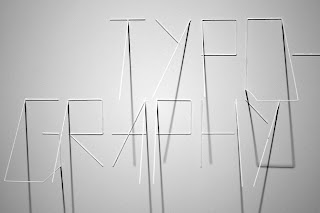Furthering the
notion of form and different methods decaying, I broadened my research to find
these sculptures titled Spomenik (Monument).
This brought about questions toward the definition of trend. If
something is beautiful in a certain time period, why is it not eternally cast
in this lighting? History has revoked every colour, every shape, then purging
it back into fame; as the trend cycle goes.
But with these
sculptures in particular, with their strong sense of form transposing then into
an isolated beauty. These sculptures being so ahead of their time, I wonder to
myself, why did the Slavic community let their physical presence disintegrate
into an abandoned ideal supposedly standing for peace?
With the way
society has become so virtual based, it is no wonder that Joseph Churchward’s handcrafting
method is dying out. The allure for taking the easy route and going digital? No
matter what medium, you cannot defy something truly beautiful and
aesthetically, physically angelic. I
believe that time is the ultimate device for the resonance of beauty; time
defines the difference between the fickle nature of a novelty movement.
Henceforward the
fact that these Spomenik sculptures have just been revoked into my image bank,
their beauty has risen again – History, on loop.
The act of being
commissioned by your government to symbolize patriotism and strength as a
nation? How do you resonate peace?
"These
structures were commissioned by former Yugoslavian president Joseph Broz Tito
in the 1960s and 70s to commemorate sites where WWII battles took place, or
where concentration camps stood.
They
were designed by different sculptors (Dušan Džamonja, Vojin Bakić, Miodrag
Živković, Jordan and Iskra Grabul, to name a few) and architects (Bogdan
Bogdanović, Gradimir Medaković...), conveying powerful visual impact to show
the confidence and strength of the Socialist Republic. In the 1980s, these
monuments attracted millions of visitors per year, especially young pioneers
for their "patriotic education." After the Republic dissolved in
early 1990s, they were completely abandoned, and their symbolic meanings were
forever lost."
Heres
an article on the matter: http://grupaspomenik.wordpress.com
Grupa Spomenik
Between 2002 and 2006, the discussion group Discussion
about Artwork has actively commented on the competitions for the “Monument
dedicated to wars on the territory of former Yugoslavia” by Belgrade City
Municipality. The group has also discussed the ideological trajectory of the
changes of the title of the monument, in parallel with the changes of the state
ideology in the field of public memory, which followed the serial of
unsuccessful competition. These changes were actually indicative for the
impossibility of the naming of the monument. Each new competition generated the
new discussions on key issues connected to the impossibility to name and build
such a monument, but also the very discussions generated conflicts among the
participants, which resulted in the splits inside the group Discussion about
Artwork.
The group called Spomenik (Monument) was formed as the
result of this splits and differentiations. Through the political
differentiations inside the Discussion about Artwork discussion group, where
the whole debate started, as well as through conflicts with representatives of
the State ideology, the Monument group persisted in the continuation of the
public debate related to the issues, generated by competitions for the
monument.
Grupa Spomenik asks the question: Is it possible to
produce a monument that is dedicated to the wars and dissolution of Yugoslavia
if its dissolution disputes the very context of the State that proclaims itself
to be the keeper of the historical continuity and memory? Is it possible for
the State to represent imperial wars, refugees, terrorized civilians and
genocide on the citizens of the states that seceded from Yugoslavia without any
insight into its own responsibility for these tragic events?
Grupa Spomenik has been active in the broadly conceived
fields of art practice and theory, developing strategies and generating a
political space to enable a discussion on the Yugoslav wars of the 1990s and
the existence of the post-war collectivities in the region. In this space we
aim to produce a monument that will neither follow the ossifying politics of
monuments, nor the prevailing models of reconciliation. The monument in
question is in the process of becoming — it consists of a collective in which
each entity defines its own political position.
Grupa Spomenik exhibits an installation made out of
“Politics of Memory” publications as a “participative object”, as to say
“distributive monument”
In this way the publication that is a transcript of the
(im)possibility of building a monument, becomes a public discussion, stays in
the hands of the viewer, and the exhibited installation in the form of the
monument disappears.
Grupa Spomenik (Nebojša Milikić
Branimir Stojanović, Milica
Tomić),
Belgrade 2007/( Grupa Spomenik (Damir Arsenijevic, Ana Bezic, Jasmina
Husanovic, Branimir Stojanović, Milica Tomić) Tuzla-Belgrade
2008






